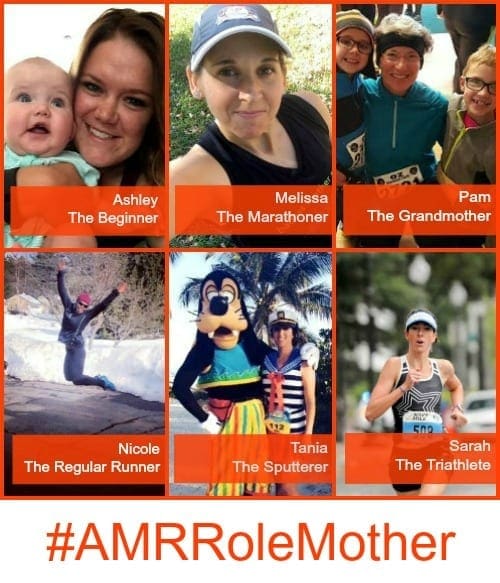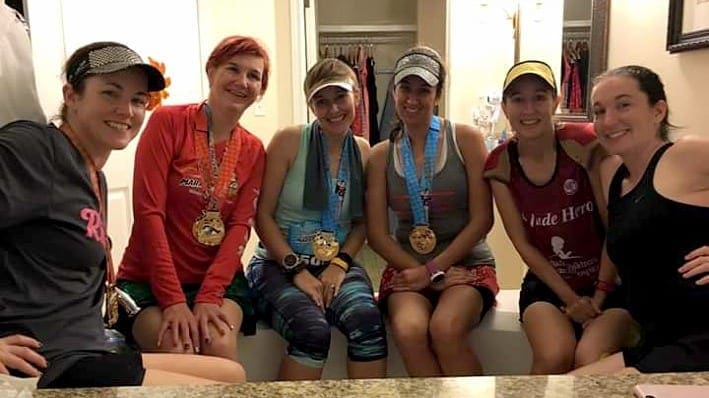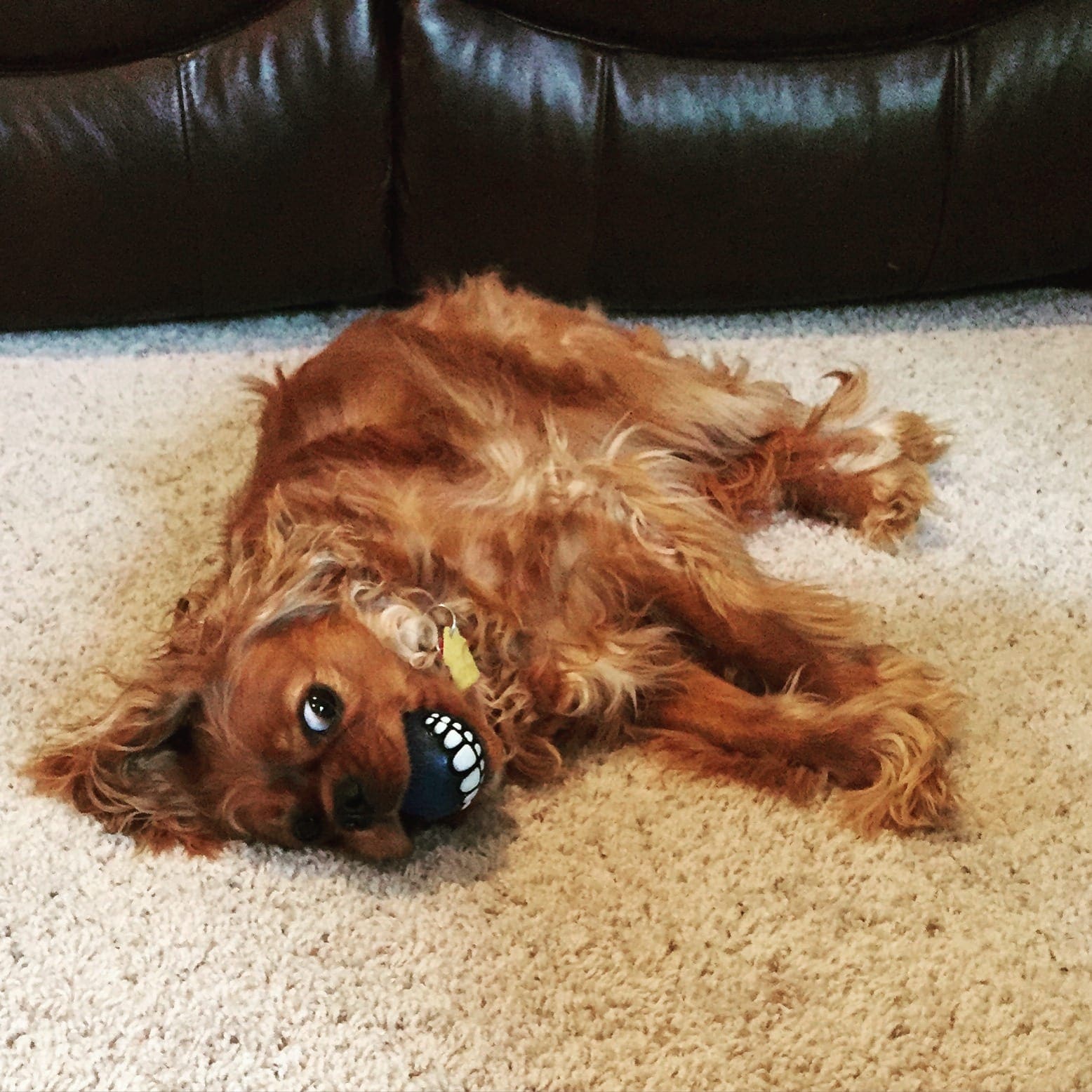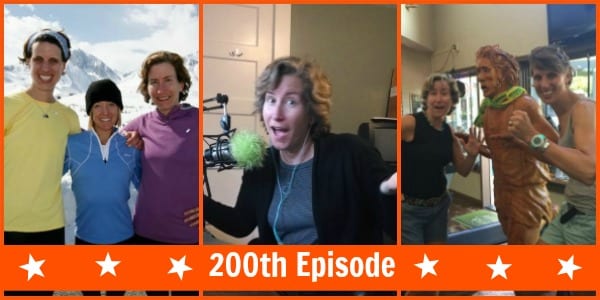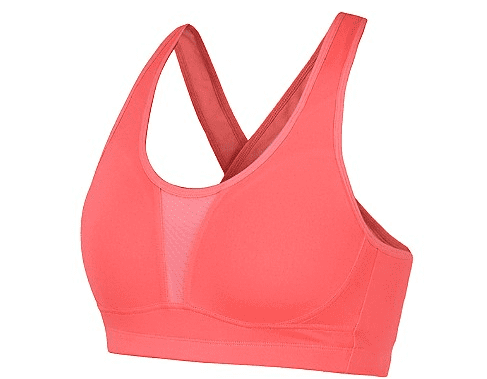Tell Me Tuesday: Sleeping Tips for Runners
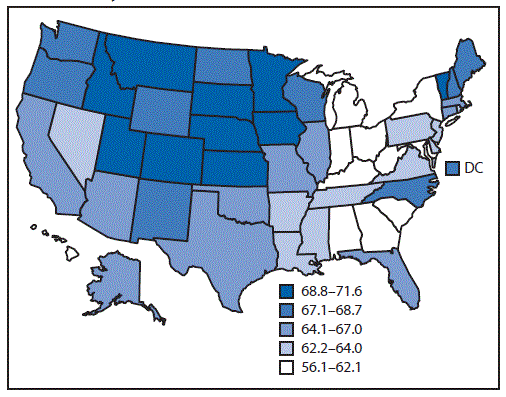
Age-adjusted percentage of adults who reported ≥7 hours of sleep per 24-hour period, by state, from a 2016 Center for Disease Control and Prevention report.
I know I’m preaching to the (dark-eye-circled) choir here, but it seems like every day, there’s a new study that extols the importance and benefits of sleep. The Zzzz’s-news bombshell in February was that one in three—a full third of American adults—don’t get enough sleep. Last week, it was about how hard it is to resist Cool Ranch Doritos when you’ve had less than five hours of sleep.
As a morning glory, I naturally start to wind down around 8 pm. On nights I’m not in bed by 9:30, I have a minor freak-out, knowing how significantly sleep—or lack thereof—can affect my mood, my outlook, my interactions with others. My tendency towards depression is directly related to sleep; the less shut-eye I have, the more powerful my depression feels. When I don’t have a solid 8ish hours, having a positive and pleasant perspective the following day can be a real struggle. It sounds dramatic, but it’s my truth.
So when somebody on Twitter asked me recently to share my sleep hygiene—an awkward word combo if I ever knew one, btw—I bit. Again, I am naturally a morning person, so if you’re not, these might feel completely awkward. Also, my kids are now nine and twelve, so they only disturb my sleep when they’re sick or having a bad dream, which happens once a month, max.
—I go to bed at what many would consider a ridiculously early hour. 9 pm most nights, and often earlier. Whenever I stay up late to get something done, my work is subpar and needs an additional polish when I’m rested. I’ve learned I’m better off getting up what many would consider ridiculously early—5 am—to get something urgent done I wasn’t able to complete the day before. (The bonus when this happens? I usually run around lunch, in the daylight, in the sun. I’m finding I actually prefer that rhythm more than an early morning run.)
—I get ready for bed 30 minutes before I want to crawl under the covers. Not only does changing into my PJs, brushing my teeth, washing my face, and whatever else I need to do to bring a sense of closure to the day, it also eliminates that I-need-to-go-to-bed-but-I-have-no-energy-to-get-there hurdle. Honestly, sometimes I’ve sat through an extra hour of a Shark Tank marathon simply because the momentum necessary to get ready for bed felt too monumental.

If you set one to remind you of bedtime, you will be awesome.
—I’ve heard people set alarms to go to bed—a brilliant idea, in my mind, if you’re a night owl and/or tend to look up from surfing the sale items at Banana Republic and think, “Where did an hour just go?”
—I exercise. No duh, right? But I find it’s a really fine line. An hour or less of exercise, and my eyes close pretty quickly after I get in bed. After long runs and races, though, I’m still pretty ramped up 12 hours later. It’s usually a night of tossing and turning. I’ve learned to just expect the turmoil, then the following night, I’m extra diligent about winding down early.
—I keep the room cool, much to my husband’s chagrin. I’m not peri-menopausal yet, but I have that special female superpower where I can wake up with a soaked T-shirt, no apparent reason why. Even on the chilliest nights, the window over my side of the bed is slid open at least a crack, and if I had my way, the ceiling fan would spin all year long. Experts say 65 degrees is ideal, but I’m more of a 62-degree devotee.
—I don’t eat much the hour or two before bed. Please don’t mistake: that doesn’t mean I don’t eat too much during the day (that happens regularly) but I’ve realized a full stomach in the evening often translates to a restless sleep. That means I occasionally wake up at 2 am with a gurgling belly. When that happens, I slip down the stairs, grab a banana (and slap some PB on it, if I’m extra hungry), and head back to bed.
—I rarely take my phone into the bedroom—and I definitely don’t charge it there. I’m not a no-screens-in-bedroom purist; I regularly watch movies on my laptop in bed, but Netflix and texts/emails are two different animals. I really try to avoid the latter.
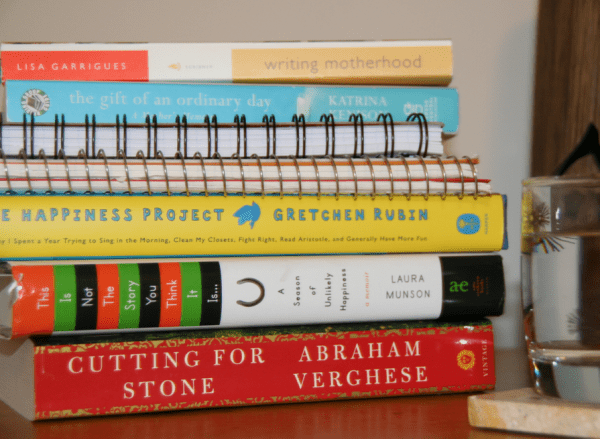
Not the pile of books near my bed: just a representation. (This is way neater.)
—I always read before I fall asleep. I’ve come home from a party at 11 pm, and turned on the light to read, even if it’s only a few pages that I don’t remember the next day. Written words are like my lullaby—even Stephen King could put me to sleep. I realize this is likely genetic. Grant, my husband, is the opposite: He starts a book, and can’t put it down for hours.
—I have a God’s in-box, an idea straight from my hero Anne Lamott; if that’s not your thing, worry dolls or journals work the same way. When something is weighing on my mind so much, I can’t let it go, I write it down and put it in His/Her inbox, which lives on my jewelry box. The simple act of moving it from my head, through a pen, to a place where it can live away from my body is surprisingly liberating.
What about you? Any sleeping tips for runners you’d like to share? How do you natural night owls wind it down?
Role Mothers’ Rules for Strong Feet (and Injury-Free Feet)
Happy feet are strong feet. Strong feet are what propel you stride after stride, mile after mile. While each runners’ history and preferences vary, our Role Mothers are offering up their foot-care regimens to share what works and what doesn’t. Pick up some insider tips and tricks to work into your own pre- and post-running routine.
Nicole, the regular runner:
Soon after I started running seriously and regularly, I got hit with plantar fasciitis. Ugh. So I make a real effort to take care of my feet. This means making sure I always have the right support and insoles when it comes to my running shoes. I also take it easy with plyometrics. I’ve noticed that the jumping (j-jacks, jump rope) can stir up PF for me. When PF does act up—which hasn’t been often (knock wood)—I take extra time to stretch and roll out the foot.
I’m a shoes gal, but thankfully don’t have to wear crazy high heels most days—this definitely spares my feet. I also treat myself to spa pedicures and reflexology massages as often as I can.
Tania, the sputterer:
The best combination I’ve found for blister-free running is the proper shoes (I love Saucony Hurricanes) and Body Glide and Vaseline slathered all over my feet. I mean slathered. It may sound a little gross, but it hasn’t failed me since. Oh and the proper socks! I’m a Balega girl, but everybody has their own preference. I did not get one single blister during my marathon, something I was extremely grateful for.
Also, after a long run, I soak my feet in Epsom salt. And if you’re lucky enough to run a race with your BRFs, then you can have an Epsom salt bathtub soak party. It’s good for the soul and the feet to share race stories and memories.
Pam, the grandmother:
My third and fourth toes on my right foot have a little deformity that involves the metatarsals and if I step just right or the toebox of my shoes is too small I can be in pain for a few days. But luckily a few years ago I discovered some silicone toe separaters that usually relieve the pain for the most part. I also switch out the insoles of my Sauconys for some sort of athletic insole. I use Sofsole most of the time but have also used Dr. Scholl’s. And I wear socks that have some cushion. I started wearing Balega Enduro socks at the beginning of the year and really like them, I also like the C9 socks from Target. My feet seem to like more cushion the older I get.
Ashley, the beginner:
My secret weapon is…. a tennis ball. I had just finished running on the treadmill and one of our sweet dogs, Penny, wanted to play fetch. Sitting on the bench, I kicked my shoes off and used my feet to stop the ball and kick it across the basement for her. In that moment, it dawned on me: “That feels pretty good on my aching feet.” Now after a run, I have a date with my foam roller and a tennis ball.
Melissa, the marathoner:
One major thing that I believe is keeping my feet injury free is sock choice. For years I bought whatever the cheapest athletic sock was in stock, until one day I splurged on a high-end, more quality brand. What a difference! Socks can be just as important as shoes when it comes to keeping you injury free AND comfortable, so don’t cheap out. Your toes will thank you!
Sarah, the triathlete:
You would think that after decades of running, I would have nailed down a foot-care regimen to eliminate some of the aforementioned issues. Truth is, my boats are pretty darn neglected. Aside from the obvious stuff, like buying shoes in the right size and resting any injuries, I really don’t pay too much special attention to my feet, but I had a pair of custom insoles molded from my feet at a local running shop. They provide extra support and a boost to my super-low arches.
I’m also susceptible to sore, tight arches post-run and swim, so I always have a foot roller like the TriggerPoint Nano X nearby to work out any aches and keep everything loose. Or I just grab a tennis ball or one of my kid’s rubber balls, which’ll do in a pinch.
What do you do to keep your feet happy, healthy, and strong? Tells us below.
#200: 200th Episode: Best-of Another Mother Runner Podcast, Part 1
Like crossing the finish line of a marathon, Sarah and Dimity have reached an important milestone – 200 episodes of the Another Mother Runner podcast!! This episode is the first of two shows with highlights from the past 99 episodes. Some are laugh-out-loud funny, like Nicole Blades recounting her “joggity-jogger-jog” conversation with her doctor, while others are more inspiring, like Olympian Deena Kastor describing how she “unlocked a well of energy” in her world-record Masters half-marathon race. One mother runner’s details of the start of last year’s Boston Marathon is sure to make you snort! Speaking of Boston, one snippet is Sarah talking about digging deep during her most recent BQ marathon. All excellent stuff on this mother runner podcast!
*If you’re digging our podcasts, we’d be super-grateful if you’d take a minute (because we *know* you have so many to spare!) to write a review on iTunes. Many thanks.
**Also, the quickest way to get our podcasts is to subscribe to the show via iTunes. Clicking this link will automatically download the shows to your iTunes account. It doesn’t get any simpler than that. We’ve also joined the Acast podcast network, download their app to hear our podcast and many others like it!
Coming of Age: a Tale of Aging and Running Speed
Sarah’s essay about aging and running speed originally appeared in Tales from Another Mother Runner. She wrote the essay in the summer of 2014; she went on to qualify for the Boston Marathon in a time of 3:56:54 that fall. We’re running it today as she’s entering a new decade tomorrow (i.e., it’s her birthday!).
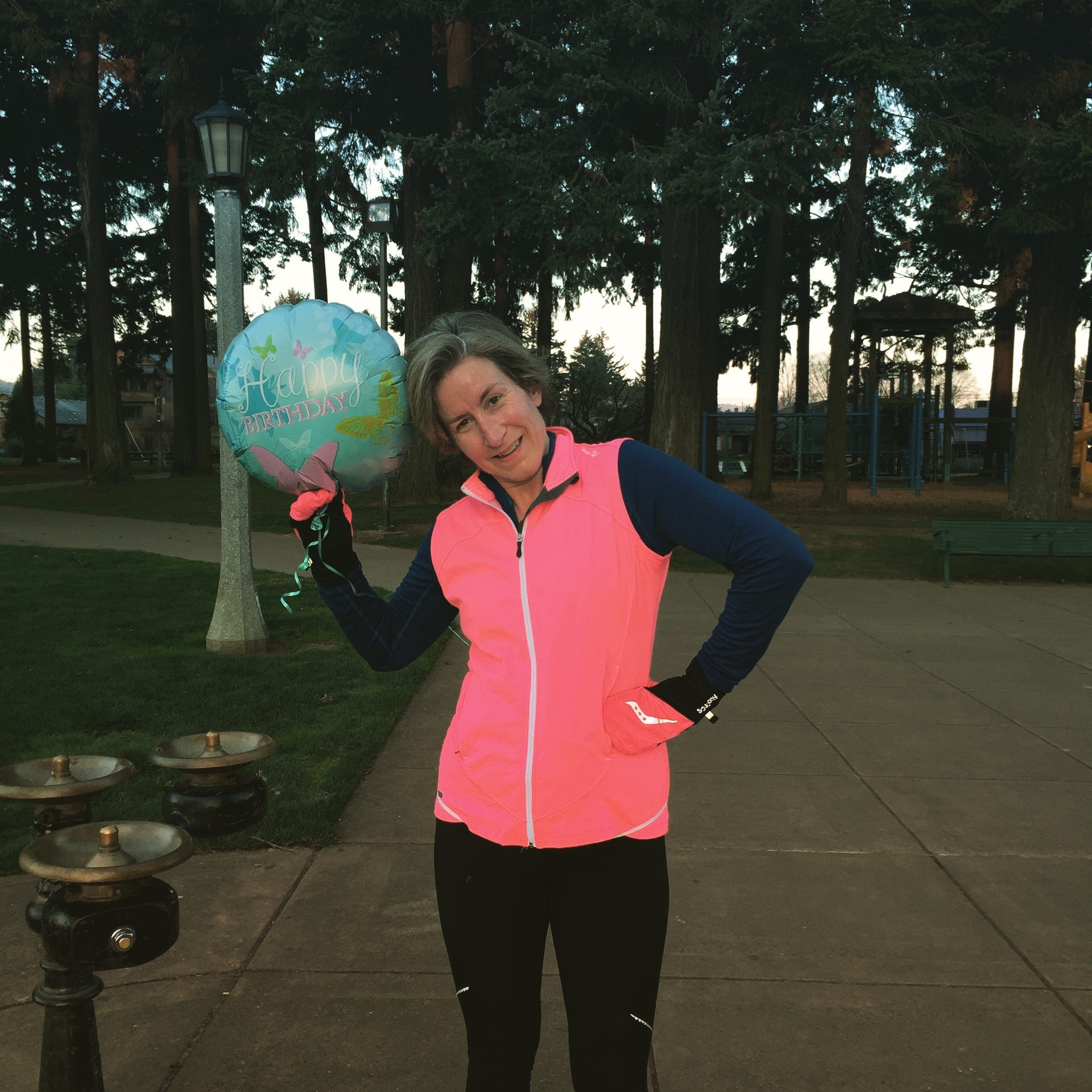
Last year, my best running friend, Molly, made me run with a helium balloon tied around my waist on my birthday. Because that’s what friends are for.
Because it’s mid-July here in Portland, sunlight sneaks through our bedroom blinds even though it’s only 5:30 in the morning. I slowly open my often-creaky closet door in hopes of not waking my husband, Jack, or our light-sleeping, early rising son, John, whose bedroom is closest to ours. It’s week five of training for the Victoria, B.C., marathon, and my coach has prescribed a fifty-minute run with some fartlek speedwork sprinkled into the otherwise-comfortable running pace. Five bursts of thirty-second intensity, then four repeats of two minutes of tempo effort. In an already challenging training plan that stretches out another three months, it’s a four on a one-to-ten scale of tough.
I slip on a patterned running skirt just as Miller, our tabby cat, starts nudging my lower legs in hopes of getting fed. In one motion, I turn around and bend to pet him. When I stand back up, I’m greeted by my reflection in the full-length mirror on the back of the open closet door.
Slats of sunlight illuminate my save-for-the-skirt naked body. When, I wonder, did my barely B-cup breasts acquire the ability to hold a pencil under them? Even after breastfeeding all three of my children, my boobs had still held their own in the upright category. Now, I notice, they are melting down my ribs.
I rotate for a profile view. My stomach strains the skirt’s waistband. My belly was always my least-favorite part of my 5’ 11” body, but my loathing of it has only intensified since becoming a mother. After the birth of my older daughter, now twelve, I’d committed myself to twice-weekly Pilates classes. The Boat Poses, Hundreds, and other challenging, core-centric exercises finally had given my abs a wee bit of definition. For the first time since my early teens, I hadn’t had to furiously suck in my gut at the pool.
Then I got pregnant with twins, and the duo did a number on those muscles, stretching them before they were sliced by the OB/GYN’s scalpel. Despite now taking a barre-inspired class every Tuesday and Thursday, which serves up a fair share of strenuous ab work, I’ve lost hope of ever getting rid of my gut. Being launched into early menopause only made matters worse. As I stand gaping at my paunch, the term “menopot” springs to mind.

Doing PT last summer. Saucony Impulse Shorts + Another Mother Runner sweatshirt hide my menopot!
I slip a Saucony bra over my head to scoop up my heading-south chesticals, and numbers flitter through my mind. I’ve always had a good memory and a head for dates, which translates into being able to easily recall my race times. Plus, I work hard for my results, so I like having them handy in my back pocket to bolster my sports ego when it flags or, yes, to #humblebrag occasionally. At age forty-three, I set all my big personal bests. A 1:46 half-marathon, 3:52 for the marathon, and equally speedy-for-me times in the 5K and 10K. Times that were, save for the half-marathon, the fastest in my life — not just that decade. I sigh, which only makes my bulging belly swell even more. I contemplate my current marathon goal — less than four hours — as I struggle to hook the bra’s clasp. It was the number I strove for throughout my thirties, when I first starting running 26.2-mile races.
My finish times of my previous ten marathons have mostly danced around the four-hour mark. A 4:03 in my debut marathon as a divorced-with-no-kids thirty-two-year-old. A 4:01 at age thirty-six, fourteen months after giving birth to our older daughter. The same time in the super-hilly Big Sur Marathon after training with a coach at age forty-four. A Boston-qualifying 3:59:54 later that same year.
After being sidelined with plantar fasciitis for roughly four months the next year, however, my times dramatically slowed down: 4:43 in the (record-hot) Boston Marathon and 4:08 in the Twin Cities 26.2. Going half the distance didn’t help matters much: In the blink of an eye, it seemed, my half-marathon finish times all clustered around 1:58 or 1:59. No matter how hard I pushed over the course of the 13.1 miles, I barely squeaked in under two hours.
While my foot was hobbled with PF, my uterus had stepped out of line, deciding to bleed almost as often as it didn’t. That summer was a sea of red that suddenly parted that autumn, leaving me without a period for almost a year. Just before I crossed the finish line into menopause (which is vaguely and frustratingly defined as the cessation of menstruation for twelve months), my period made a brief appearance, never to be seen again. I hadn’t been hit hard with many menopausal symptoms like hot flashes or dry lady-parts, but I didn’t need an M.D. to connect the dots between menopause and tougher times, both physically and mentally, in races.
I was embarrassed to have gone into early menopause — psychologically, it made me feel like a senior citizen when it often seems like high school was years, not decades, ago. No one else needed to know I was now barren, but I knew, and I felt it as I hoofed around our neighborhood. Early menopause was like a banana peel I’d slipped on as I progressed along the aging-process path.
Even as I’m learning to cope with my menopot and all the other issues “The Change” brings, I have to acknowledge the main reason I’m slowing down: age. I could lose weight and regain some speed. (For every pound lost, studies suggest a runner can go two seconds faster per mile. Over the course of a marathon, losing five pounds would translate to finishing four minutes, twenty-two seconds faster; dropping ten pounds would shave almost nine minutes off the clock!) And I could redouble my effort at strengthening my core (recently, when I bemoaned my belly, Dimity suggested I hammer out a plank a day), and probably gain some seconds there. But I love desserts too much to drop any pounds and planking as I focus on my kids’ candy wrappers under our basement couch just isn’t going to happen. The hard truth is, like all us mother runners, I’m getting older. Sigh.
According to World Masters Athletics, runners slow about seven percent per decade in their forties, fifties and sixties. (The decline is even more precipitous beyond that point.) In addition to having no head for science, I’m lousy at math, but good ol’ Google tells me that means adding 4.2 minutes for every hour of race time for my golden 4:00 marathon. Right there, in one decade, is about seventeen additional minutes. Ouch.
In my thirties and even early forties, any start-of-run sluggishness disappeared by the time my GPS beeped out the first mile. In my mid-forties, I needed to get two miles under my legs before they felt decent; now that I’m forty-eight, I feel slow and lumbering until mile three. A 10:30- or 10:15-pace in those first few miles feels as strenuous as an 8:45 felt in my twenties or 9:15 felt in my thirties. It’s demoralizing and daunting.
These days, once my engine gets moderately warm, it takes more effort to make it rev. My hips seem less willing to let my legs drive forward and back with sufficient intensity; my knees sometimes suddenly seem to zig when the rest of my body zags. (And now they cr-cr-creak whenever I squat to sit on the toilet.) If I stop too suddenly at an intersection, my glutes occasionally seize up. Even my stinking hammertoe — my curled-under, pork-rind of a little right toe — shrieks louder and more frequently during runs than it did even just a year ago.
For most of 2013, a year scattered with half-marathons but no 26.2s, I started to accept the fact I was almost a card-carrying AARP member. Running runDisney races made the I-am-getting-woefully-slower reality a bit easier to accept because those full-of-photo-ops races aren’t about the time on the clock. I told myself my 2:15 at the 2013 Tinker Bell was because of posing with Mrs. Incredible and Aladdin, but when I was honest with myself, I admitted it was because I didn’t have the juice to go faster.
Reluctant to stare down a start line knowing my finish time would only make me feel geriatric, not jaunty, I didn’t race much in the spring and summer of 2013. Meanwhile, in “real” life, I kidded myself that the thatch of white hairs at my part blended in with my blonde highlights. As the months flew by, the furrow between my eyebrows became almost deep enough to plant a row of carrots.
As fall approached, a quick backwards-count on the calendar told my running partner, Molly, and me it was time to start training for our mid-January half-marathons. I was headed back to Disneyland for Tinker Bell, and Molly was running a small, tabletop-flat local race that promised fast times with diligent training. Despite my belief I no longer possess what it takes to fly, I jumped on a moderately aggressive training program to support Molly.
For the first time in more than a year, I put my nose to the workout grindstone. Tempo runs, intervals, and hill repeats. (I only remember where the big hills in our neighborhood are located because I’d been avoiding them for eighteen months!) My lungs heave, my quads ache, and my head feels a bit fuzzy after the bursts of exertion. But I also am exhilarated when Molly and I run 400-meter repeats at the recently refurbished high school track in 1:58s, then 1:55s, then 1:52s. We hit the track every Monday morning and do tempo runs every Wednesday. The more intense workouts restrict the flow of conversation, making me realize our runs over the past year had become in-motion gab sessions, not speed-honers.
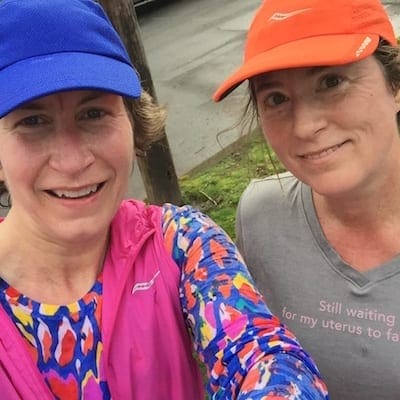
Always there to give encouragement: Molly (orange hat) and me after 16-mile run last Saturday.
One December morning, as heavy clouds obliterate the early morning light, Molly and I are running the second of two two-mile tempo segments on a neighborhood street where the only inclines are speed bumps. We’d agreed we’d each run our own pace, and in the second mile, I am nearly two blocks ahead of Molly. My strides are relaxed and smooth, a gazelle-like sensation I hadn’t felt in several years. At the end of the two miles, a smile creeps across my face between shallow, rapid breaths.
“You have newfound speed, Sarah,” Molly pants. “You should run a race before Tinker Bell to see what you can really do.”
For the next few days, Molly’s comment bumps around in my brain. While I love running in a crowd of tutus, I needed fewer runners and cooler temps to know what I was capable of on a race course. With an abbreviated, four-day taper, I toe the start line of a holiday-themed half-marathon, replete with a green-and-red felt Christmas tree quilt pinned to the back of my running vest. Surrounded by runners decked out in fuzzy reindeer antlers and candy-cane-striped knee socks, I am optimistic.
I give myself an unstructured time goal — closer to 1:50 than 1:55 — to allow my pace to be fluid, rather than laser-beam precise. This race is about seeing what I have left in my legs, not fretting if varicose veins are developing on them. By mile two, I surprise myself with how comfortable and controlled an 8:35 pace feels. I only occasionally glance at my GPS, choosing to run by perceived exertion; I’m aiming for a six or seven on a one-to-ten scale. I pay careful attention to fueling and hydration — Nuun and a GU at miles four, eight, and eleven — because gone are the days of winging it in a race.
The excitement of the crowd and seeing friends along the course carries me through mile ten. I dig a little deeper, and I spot runners to pass. My limbs feel surprisingly supple and cooperative, and I am able to maintain a brisk pace. In the final mile, the thrill of picking off runners, some of them firm of flesh and young of age, makes my steps feel a little lighter. Or maybe it’s the slight downhill to the finish. Either way, my finish time is 1:53:12. Closer to 1:55 than I’d hoped, but an online search later tells me it’s the fastest half-marathon I’ve run in more than three years. Menopot or no, my mother runner legs still have a spark.
Now, in the July morning light with Miller meowing insistently, I pull on my grey-and-pink badass mother runner hat, and I stare at my reflection one final time. I know many challenging workouts — much closer to the “ten” end of the exertion scale than the “one” side — await me during the next few months of marathon prep. A sly smile creeps across my face. Sure, I have laugh lines and need reading glasses, but I also know with age comes wisdom. I am wise — and old — enough to know I have a few more good and speedy years left in this body.
What’s your attitude on aging? Pros? Cons? We want to hear all of it below.
Role Mothers Reveal: the Secret to the Best Sports Bra for Running
When you think about essentials, you can’t get around the necessity of a solid sports bra. The right one for your body and running style will let you leave any comfort issues behind and concentrate on a good run. Enter our Role Mothers. They come in all shapes and sizes and run at every intensity level, offering a wide range of experience, thoughts, and opinions on the matter. Find your sports-bra spirit runner below and absorb their sage advice to find the best sports bra for running.
Nicole Blades, the Regular Runner:
I have 10 sports bras, but not all of them are in steady rotation. In fact, there’s one from waaaay back that only comes out when all others are in the midst of the wash cycle. I typically wear five of them and the others serve as back-up.
I have an odd size that can be a challenge to find. I’m a 32E, so for me, the secret to a good sports bra is the right fit and also feel. It needs to have really good support and control to reduce the “bounce,” but it also needs to be comfortable—and by that I mean, a smooth shape with flat seams that all come together and rest softly against my skin.
My all-time favorite is either the Panache Ultimate Maximum Control Sports Bra or the Medium Control Wire-Free Sports Bra.
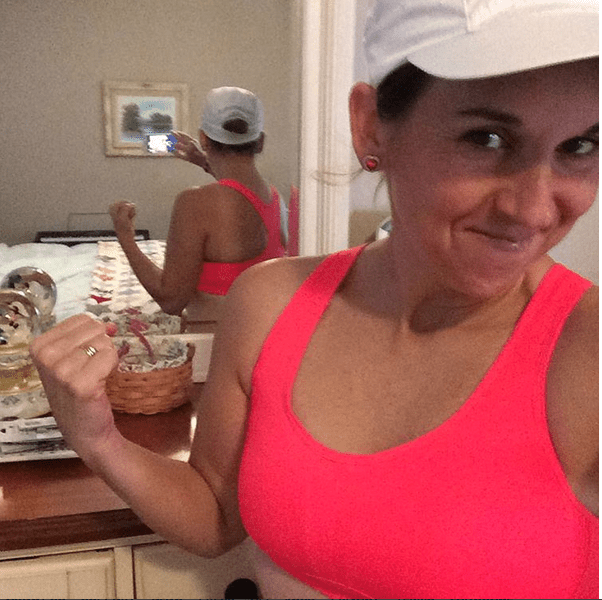
Melissa explains on Instagram: “My first @Saucony sports bra selfie…do you know how much courage this took? GULP…Let’s do this!”
Melissa Fenton, the Marathoner:
Because I’m in such a hot and humid climate, my sports bra needs to be made of a lightweight fabric, but still offer decent compression. I like wide straps that don’t dig into my shoulders. I don’t like any padding (too hot!) and don’t mind hooks, if it helps get a better fit—and they’re also nice for certain times of the month when my breasts change in size and tenderness.
One of my favorites is the Saucony Athlete Avenger. No bounce! And breathable. It’s practically neon, but actually I love that you can see the bra underneath a mesh-type top. And also, BONUS: It covers enough/is not see-through, so that I could wear it as-is, without a top, and run in it. (Again, hot as hell here so I lose my top a lot on runs.)
Ashley Hinze, the Beginner:
Motherhood did a whammy on my chest. Pre-baby = no boobs at all, immediately following baby = huge boobs needing serious control, returning to post-baby body = ending up somewhere in the middle and still needing support.
I always look for straps that cross in the back to hold those babies in! I prefer the no-movement type. This is crucial, as my bra is the last thing I want to worry about on a run.
My favorite is the Saucony Curved Crusader. It has just the right support, but comfortable enough to wear all day.
Tania, the Sputterer:
I probably own around 10 sports bras and wear about three of them on a regular basis. I wear the others if I need a specific color for a running costume.
For me, the secret to a good sports bra is fabric that doesn’t chafe. Since I’m not well endowed, I also need some padding. But not funky shaped padding. Honestly, the best bras that I’ve found for me are from Old Navy.
Pam, the Grandmother:
I have more than a dozen, but I only wear about five of them on a regular basis.
The secret to a great sport bra is the fit and support. I really like the girls to stay put when running. I also like a sports bra with hook and eye closure, partly because they are easier to get on and off.
Our local running store carries Moving Comfort bras, and I really like those. But my new favorite is the Saucony Bounce Trouncer. It has a very comfortable band and fits great. No chafing!

Sarah pushing through a six-mile treadmill tempo (10 minutes at 6:10!) and showing off her Saucony sports bra
Sarah Wassner Flynn, the Triathlete:
I currently own five sports bras, which I wear on a regular basis, plus another five tanks with built-in bras which are also on heavy rotation.
As a small-chested woman, I don’t have much to support, so I focus mostly on comfort and color. I tend to skip bras with fussy details like padding and hooks, opting for softer, stretchy fabrics and surprising elements, like a strappy back or a keyhole racerback.
I love both the Saucony Athlete Avenger and Sweet Elite. The bold, bright colors are totally my vibe and the fit is on-point. I’m also a fan of C9 bras from Target. They’re super-affordable and comfortable, too.
We want to know: What do you love about your sports bra(s)? Tell us in the comments section below.


